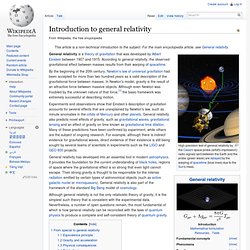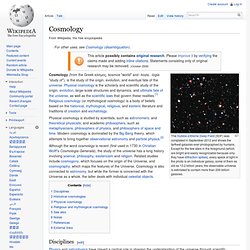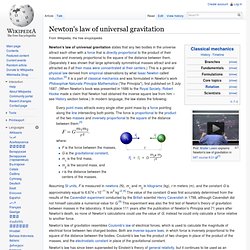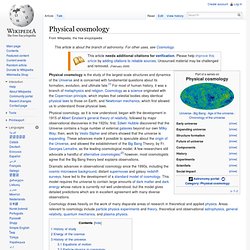

History of Cosmology. Cosmology is the study of the Universe and its components, how it formed, how its has evolved and what is its future.

Modern cosmology grew from ideas before recorded history. Ancient man asked questions such as "What's going on around me? " which then developed into "How does the Universe work? ", the key question that cosmology asks. To religious studies, cosmology is about a theistically created world ruled by supernatural forces. Many of the earliest recorded scientific observations were about cosmology, and pursue of understanding has continued for over 5000 years. Modern cosmology is on the borderland between science and philosophy, close to philosophy because it asks fundamental questions about the Universe, close to science since it looks for answers in the form of empirical understanding by observation and rational explanation. Neolithic Cosmology: Cosmology is as old as humankind. Egyptian/Mesopotamia Cosmology: Nut is often portrayed as a naked female stretched across the sky.
Introduction to general relativity. High-precision test of general relativity by the Cassini space probe (artist's impression): radio signals sent between the Earth and the probe (green wave) are delayed by the warping of spacetime (blue lines) due to the Sun's mass.

General relativity is a theory of gravitation that was developed by Albert Einstein between 1907 and 1915. According to general relativity, the observed gravitational effect between masses results from their warping of spacetime. By the beginning of the 20th century, Newton's law of universal gravitation had been accepted for more than two hundred years as a valid description of the gravitational force between masses.
In Newton's model, gravity is the result of an attractive force between massive objects. Although even Newton was troubled by the unknown nature of that force,[1] the basic framework was extremely successful at describing motion. General relativity has developed into an essential tool in modern astrophysics. Equivalence principle[edit] Cosmology. The Hubble eXtreme Deep Field (XDF) was completed in September 2012 and shows the farthest galaxies ever photographed by humans.

Except for the few stars in the foreground (which are bright and easily recognizable because only they have diffraction spikes), every speck of light in the photo is an individual galaxy, some of them as old as 13.2 billion years; the observable universe is estimated to contain more than 200 billion galaxies.
Theories of the Universe. Newton's law of universal gravitation. Newton's law of universal gravitation states that any two bodies in the universe attract each other with a force that is directly proportional to the product of their masses and inversely proportional to the square of the distance between them.

(Separately it was shown that large spherically symmetrical masses attract and are attracted as if all their mass were concentrated at their centers.) This is a general physical law derived from empirical observations by what Isaac Newton called induction.[2] It is a part of classical mechanics and was formulated in Newton's work Philosophiæ Naturalis Principia Mathematica ("the Principia"), first published on 5 July 1687. (When Newton's book was presented in 1686 to the Royal Society, Robert Hooke made a claim that Newton had obtained the inverse square law from him – see History section below.)
In modern language, the law states the following: History[edit] Early History[edit] Plagiarism dispute[edit] Hooke's work and claims[edit] Vector form[edit]
Cosmic Journey: A History of Scientific Cosmology. Physical cosmology. Physical cosmology is the study of the largest-scale structures and dynamics of the Universe and is concerned with fundamental questions about its formation, evolution, and ultimate fate.[1] For most of human history, it was a branch of metaphysics and religion.

Cosmology as a science originated with the Copernican principle, which implies that celestial bodies obey identical physical laws to those on Earth, and Newtonian mechanics, which first allowed us to understand those physical laws. Physical cosmology, as it is now understood, began with the development in 1915 of Albert Einstein's general theory of relativity, followed by major observational discoveries in the 1920s: first, Edwin Hubble discovered that the Universe contains a huge number of external galaxies beyond our own Milky Way; then, work by Vesto Slipher and others showed that the universe is expanding.